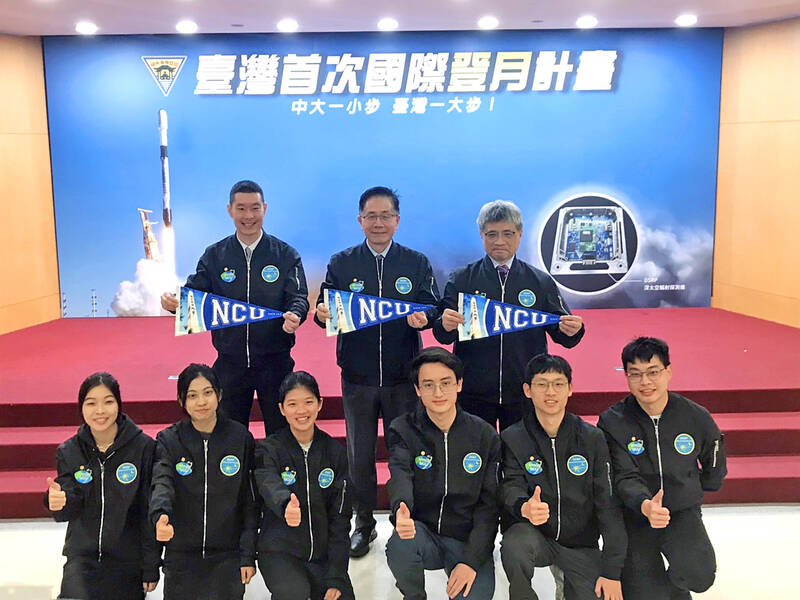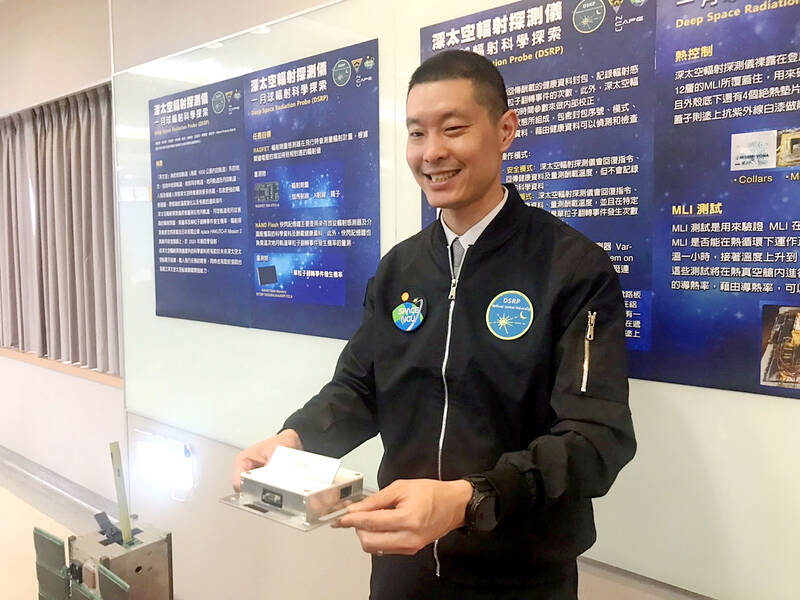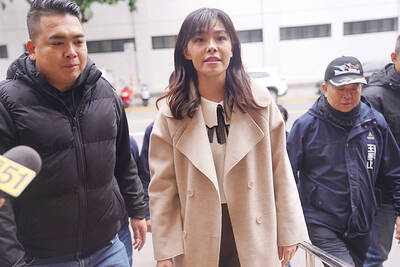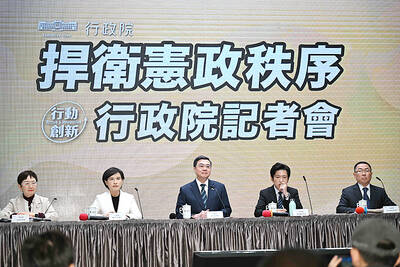The Deep Space Radiation Probe developed by National Central University (NCU) could be launched into space in the fourth quarter of this year after researchers confirmed that the system is ready for the nation’s first moon mission with a Japanese start-up.
“Pleased to report that we have successfully completed the handover of the National Central University Deep Space Radiation Probe (DSRP) payload to ispace Inc for integration with the Hakuto-R Mission 2 Resilience lunar lander,” NCU Department of Space Science and Engineering professor and dean Loren Chang (張起維) wrote on Facebook.
“Final payload software updates and functional checks were performed to verify that the DSRP flight model is ready for the mission to characterize the ionizing radiation environment from the Earth to the moon and its effects on electronics,” he wrote.

Photo: Yang Mien-chieh, Taipei Times
“Thank you to the student members of the DSRP payload team for designing, implementing and qualifying Taiwan’s first lunar payload in 21 months, as well as the ispace team for your support and guidance. We look forward to launching in Q4 of this year, as well as continuing collaboration and exchanges on this and future missions,” he wrote.
Various nations have begun planning missions to the moon in the past few years, hoping to establish permanent bases to harness lunar resources, Chang told a news conference in Taipei yesterday.
Increasingly more opportunities would be available in the near future for small and medium-sized satellites to ride along with larger projects to deep space or the moon, he said.

Photo: Yang Mien-chieh, Taipei Times
“Deep space is more than 2,000km away from Earth, and ionizing radiation in deep space is expected to create problems for electronic devices and life forms flying in it. However, the radiation is either blocked by the Earth or absorbed by the atmosphere,” Chang said.
“To have a deeper understanding of space radiation, we hope to measure it from Earth to the moon and the speed of its accumulation, which can serve as a reference for space missions or be considered when designing electronic and space products,” he added.
There are strict requirements for the size, weight and power consumption for the payload system, he said.
The weight must be less than 400g, which is equivalent to one bag of tea, and only slightly larger than the palm of a human hand, he said.
“It also needs to survive in the extreme temperatures of space for at least four months, and [we must] ensure that it does not crash and can perform its mission,” Chang said.

The US government has signed defense cooperation agreements with Japan and the Philippines to boost the deterrence capabilities of countries in the first island chain, a report by the National Security Bureau (NSB) showed. The main countries on the first island chain include the two nations and Taiwan. The bureau is to present the report at a meeting of the legislature’s Foreign Affairs and National Defense Committee tomorrow. The US military has deployed Typhon missile systems to Japan’s Yamaguchi Prefecture and Zambales province in the Philippines during their joint military exercises. It has also installed NMESIS anti-ship systems in Japan’s Okinawa

‘WIN-WIN’: The Philippines, and central and eastern European countries are important potential drone cooperation partners, Minister of Foreign Affairs Lin Chia-lung said Minister of Foreign Affairs Lin Chia-lung (林佳龍) in an interview published yesterday confirmed that there are joint ventures between Taiwan and Poland in the drone industry. Lin made the remark in an exclusive interview with the Chinese-language Liberty Times (the Taipei Times’ sister paper). The government-backed Taiwan Excellence Drone International Business Opportunities Alliance and the Polish Chamber of Unmanned Systems on Wednesday last week signed a memorandum of understanding in Poland to develop a “non-China” supply chain for drones and work together on key technologies. Asked if Taiwan prioritized Poland among central and eastern European countries in drone collaboration, Lin

BACK TO WORK? Prosecutors said they are considering filing an appeal, while the Hsinchu City Government said it has applied for Ann Kao’s reinstatement as mayor The High Court yesterday found suspended Hsinchu mayor Ann Kao (高虹安) not guilty of embezzling assistant fees, reducing her sentence to six months in prison commutable to a fine from seven years and four months. The verdict acquitted Kao of the corruption charge, but found her guilty of causing a public official to commit document forgery. The High Prosecutors’ Office said it is reviewing the ruling and considering whether to file an appeal. The Taipei District Court in July last year sentenced Kao to seven years and four months in prison, along with a four-year deprivation of civil rights, for contravening the Anti-Corruption

NO CONFIDENCE MOTION? The premier said that being toppled by the legislature for defending the Constitution would be a democratic badge of honor for him Premier Cho Jung-tai (卓榮泰) yesterday announced that the Cabinet would not countersign the amendments to the local revenue-sharing law passed by the Legislative Yuan last month. Cho said the decision not to countersign the amendments to the Act Governing the Allocation of Government Revenues and Expenditures (財政收支劃分法) was made in accordance with the Constitution. “The decision aims to safeguard our Constitution,” he said. The Constitution stipulates the president shall, in accordance with law, promulgate laws and issue mandates with the countersignature of the head of the Executive Yuan, or with the countersignatures of both the head of the Executive Yuan and ministers or